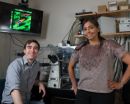(Press-News.org) Magnetic devices like hard drives, magnetic random access memories (MRAMs), molecular magnets, and quantum computers depend on the manipulation of magnetic properties. In an atom, magnetism arises from the spin and orbital momentum of its electrons. 'Magnetic anisotropy' describes how an atom's magnetic properties depend on the orientation of the electrons' orbits relative to the structure of a material. It also provides directionality and stability to magnetization. Publishing in Science, researchers led by EPFL combine various experimental and computational methods to measure for the first time the energy needed to change the magnetic anisotropy of a single Cobalt atom. Their methodology and findings can impact a range of fields from fundamental studies of single atom and single molecule magnetism to the design of spintronic device architectures.
Magnetism is used widely in technologies from hard drives to magnetic resonance, and even in quantum computer designs. In theory, every atom or molecule has the potential to be magnetic, since this depends on the movement of its electrons. Electrons move in two ways: Spin, which can loosely be thought as spinning around themselves, and orbit, which refers to an electron's movement around the nucleus of its atom. The spin and orbital motion gives rise to the magnetization, similar to an electric current circulating in a coil and producing a magnetic field. The spinning direction of the electrons therefore defines the direction of the magnetization in a material.
The magnetic properties of a material have a certain 'preference' or 'stubbornness' towards a specific direction. This phenomenon is referred to as 'magnetic anisotropy', and is described as the "directional dependence" of a material's magnetism. Changing this 'preference' requires a certain amount of energy. The total energy corresponding to a material's magnetic anisotropy is a fundamental constraint to the downscaling of magnetic devices like MRAMs, computer hard drives and even quantum computers, which use different electron spin states as distinct information units, or 'qubits'.
The team of Harald Brune at EPFL, working with scientists at the ETH Zurich, Paul Scherrer Institute, and IBM Almaden Research Center, have developed a method to determine the maximum possible magnetic anisotropy for a single Cobalt atom. Cobalt, which is classed as a 'transition metal', is widely used in the fabrication of permanent magnets as well as in magnetic recording materials for data storage applications.
The researchers used a technique called inelastic electron tunneling spectroscopy to probe the quantum spin states of a single cobalt atom bound to an MgO layer. The technique uses an atom-sized scanning tip that allows the passage (or 'tunneling') of electrons to the bound cobalt atom. When electrons tunneled through, they transferred energy the cobalt atom, inducing changes in its spin properties.
The experiments showed the maximum magnetic anisotropy energy of a single atom (~60 millielectron volts) and the longest spin lifetime for a single transition metal atom. This large anisotropy leads to a remarkable magnetic moment, which has been determined with synchrotron-based measurements at the X-Treme beamline at the Swiss Light Source. Though fundamental, these findings open the way for a better understanding of magnetic anisotropy and present a single-atom model system that can be conceivably used as a future 'qubit'.
"Quantum computing uses quantum states of matter, and magnetic properties are such a quantum state", says Harald Brune. "They have a life-time, and you can use the individual suface adsorbed atoms to make qubits. Our system is a model for such a state. It allows us to optimize the quantum properties, and it is easier than previous ones, because we know exactly where the cobalt atom is in relation to the MgO layer."
INFORMATION:
This work represents a collaboration between EPFL's Laboratory of Nanostructures at Surfaces (LNS), IBM's Almaden Research Center, ETH Zurich's Department of Materials, Paul Scherrer Institute's Swiss Light Source, and Georgetown University's Department of Physics.
Reference
Rau IG, Baumann S, Rusponi S, Donati F, Stepanow S, Gragnaniello L, Dreiser J, Piamonteze C, Nolting F, Gangopadhyay S, Albertini OR, Macfarlane RM, Lutz CP, Jones B, Gambardella P, Heinrich AJ, Harald Brune. 2014. Reaching the magnetic anisotropy limit of a 3d metal atom. Science 08 May 2014
Exploring the magnetism of a single atom
2014-05-08
ELSE PRESS RELEASES FROM THIS DATE:
Plant hormone has dual role in triggering flower formation, Penn study finds
2014-05-08
Flowers aren't just pretty to look at, they are how plants reproduce. In agricultural plants, the timing and regulation of flower formation has economic significance, affecting a crop's yield.
A new paper by researchers at the University of Pennsylvania published in the journal Science has revealed that a plant hormone once believed to promote flower formation in annual plants also plays a role in inhibiting flowers from forming. The dual role of this hormone, gibberellin, could be exploited to produce higher-yielding crop plants.
The study was led by Nobutoshi Yamaguchi ...
GaitTrack app makes cellphone a medical monitor for heart and lung patients
2014-05-08
CHAMPAIGN, Ill. — By simply carrying around their cellphones, patients who suffer from chronic disease could soon have an accurate health monitor that warns their doctors when their symptoms worsen.
GaitTrack, an app developed by researchers at the University of Illinois at Urbana-Champaign and the U. of I. at Chicago, turns a smartphone into a sophisticated medical device. Unlike other apps that merely count steps, GaitTrack uses eight motion parameters to perform a detailed analysis of a person's gait, or walking pattern, which can tell physicians much about a patient's ...
Tackling test anxiety may help prevent more severe problems
2014-05-08
Showing students how to cope with test anxiety might also help them to handle their built-up angst and fretfulness about other issues. The results of a new study by Carl Weems of the University of New Orleans show that anxiety intervention programs that focus on academic matters fit well into the demands of the school routine, and do not carry the same stigma among youth as general anxiety programs do. The research group was among the first to study the effects of Hurricane Katrina on community mental health and anxiety among youths, and the paper appears in Prevention ...
Ovarian cancer cells are more aggressive on soft tissues
2014-05-08
When ovarian cancer spreads from the ovaries it almost always does so to a layer of fatty tissue that lines the gut. A new study has found that ovarian cancer cells are more aggressive on these soft tissues due to the mechanical properties of this environment. The finding is contrary to what is seen with other malignant cancer cells that seem to prefer stiffer tissues.
"What we found is that there are some cancer cells that respond to softness as opposed to stiffness," said Michelle Dawson, an assistant professor in the School of Chemical and Biomolecular Engineering ...
Army drug users twice as likely to use synthetic marijuana as regular marijuana
2014-05-08
Social work researchers from the University of Washington have found that among a group of active-duty Army personnel who use illicit drugs, the most abused substance is synthetic marijuana, which is harder to detect than other drugs through standard drug tests.
The research will be published in the July 2014 issue of Addictive Behaviors, but is already online.
Synthetic marijuana, sometimes called "Spice," is made with shredded plant material coated with chemicals that are designed to mimic THC, the psychoactive compound found naturally in marijuana. The U.S. Drug ...
Single cell genome sequencing of malaria parasites
2014-05-08
SAN ANTONIO, May 8, 2014 – A new method for isolating and genome sequencing an individual malaria parasite cell has been developed by Texas Biomed researchers and their colleagues. This advance will allow scientists to improve their ability to identify the multiple types of malaria parasites infecting patients and lead to ways to best design drugs and vaccines to tackle this major global killer. Malaria remains the world's deadliest parasitic disease, killing 655,000 people in 2010.
Malaria parasite infections are complex and often contain multiple different parasite genotypes ...
New genomics technique could improve treatment and control of Malaria
2014-05-08
Single-cell genomics could provide new insight into the biology of Malaria parasites, including their virulence and levels of drug resistance, to ultimately improve treatment and control of the disease, according to new research funded by the Wellcome Trust and the National Institutes of Health.
The findings are revealed in a study by researchers at the Texas Biomedical Research Institute and published today in the journal Genome Research.
Malaria infections commonly contain complex mixtures of Plasmodium parasites which cause the disease. These mixtures, known as multiple ...
Open science journal publishes attempt to reproduce high-profile stem cell acid bath study
2014-05-08
In a study published today in F1000Research, Professor Kenneth Lee of the Chinese University of Hong Kong reveals the full experimental results of an attempt to replicate a controversial study published in Nature recently that suggested that bathing somatic cells in acid can reprogram them to induced pluripotent stem cells (iPS cells). With systematically collected and fully available data, Lee and his colleagues report that carefully replicating the original acid-treatment method does not induce pluripotency in two types of mouse somatic cells, including those used in ...
NASA sees system 90E moving toward southwestern Mexico
2014-05-08
A tropical low pressure area known as System 90E is located a couple of hundred miles southwest of Zihuatenejo, Mexico today and was seen by NASA's Terra satellite on its way to a landfall.
The Moderate Resolution Imaging Spectroradiometer (MODIS) instrument aboard NASA's Terra satellite captured a visible image of System 90E on May 7 at 18:50 UTC/ 2:50 p.m. EDT as it headed to a landfall in southwestern Mexico. The low appeared disorganized as it approached the southwestern coast of Mexico near the states of Michoacan and Guerrero.
According to NOAA's National Hurricane ...
Recycling a patient's lost blood during surgery better than using banked blood
2014-05-08
Patients whose own red blood cells are recycled and given back to them during heart surgery have healthier blood cells better able to carry oxygen where it is most needed compared to those who get transfusions of blood stored in a blood bank, according to results of a small study at Johns Hopkins.
In a report for the June issue of the journal Anesthesia & Analgesia, the researchers say they found that the more units of banked blood a patient received, the more red cell damage they observed. The damage renders the cells less flexible and less able to squeeze through a ...


